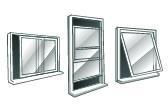
The most common and essential form of daylighting in almost all homes, windows play a very big part in lighting design.

According to the Building Code of Australia, windows are now legally required in all ‘habitable’ rooms. This access is to come through an openings of not less that 10% of floor areas. The daylight you can introduce into a room through something as simple as a window can have a profound effect on the amount of artificial lighting you require, and therefore the amount of energy you consume and pay for.
Aside from the initial cost, windows are free and require little to no maintenance beyond the occasional clean. Windows come in all shapes, sizes and styles, and work in various different ways to allow ventilation and light.
Make the most of window light
To maximise light input, windows should be placed near light coloured walls, and where possible should make use of large, light coloured window sills or frames, which will help to reflect light into the room in much the same way as light shelves do. Bay window and bow windows allow in extra light too, by adding to the angle of the window exposed to daylight.
For the best access to sunlight, windows in the main living areas of a house in the southern hemisphere should face north. Because the sun moves lower in the sky during winter, this will allow you to capture more sun during the winter months, which in turn will help heat your home.
Heat and other considerations
Too much daylight through windows, unfortunately, can generate excessive heat in your house. If you suspect this may be the case in your house, you should consider ‘energy efficient’ windows that feature glazing or window film to enhance the quality of light as well as the thermal performance of the window.
The style of windows and amount of light they admit into your home are one of many performance considerations you should take into account when selecting windows.





